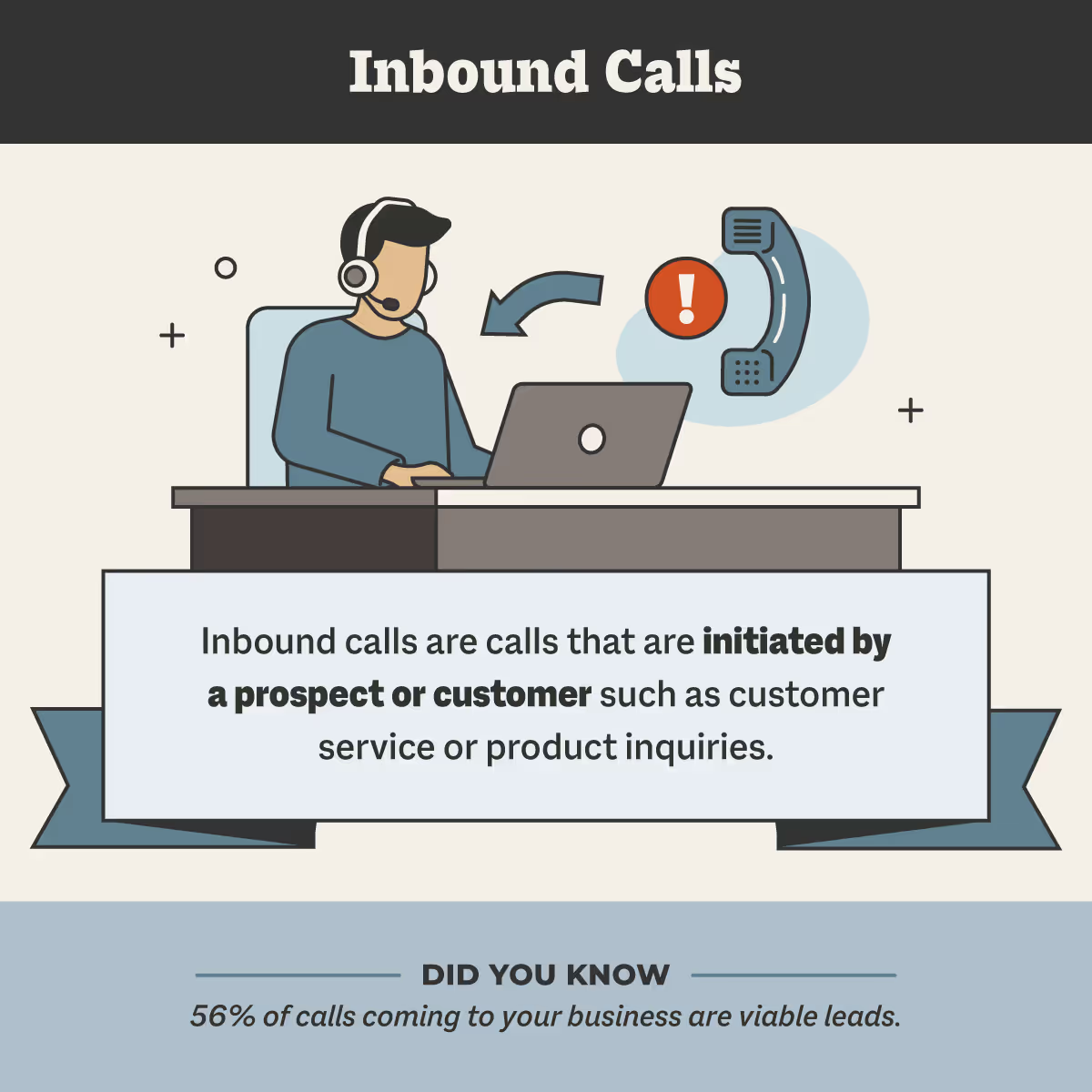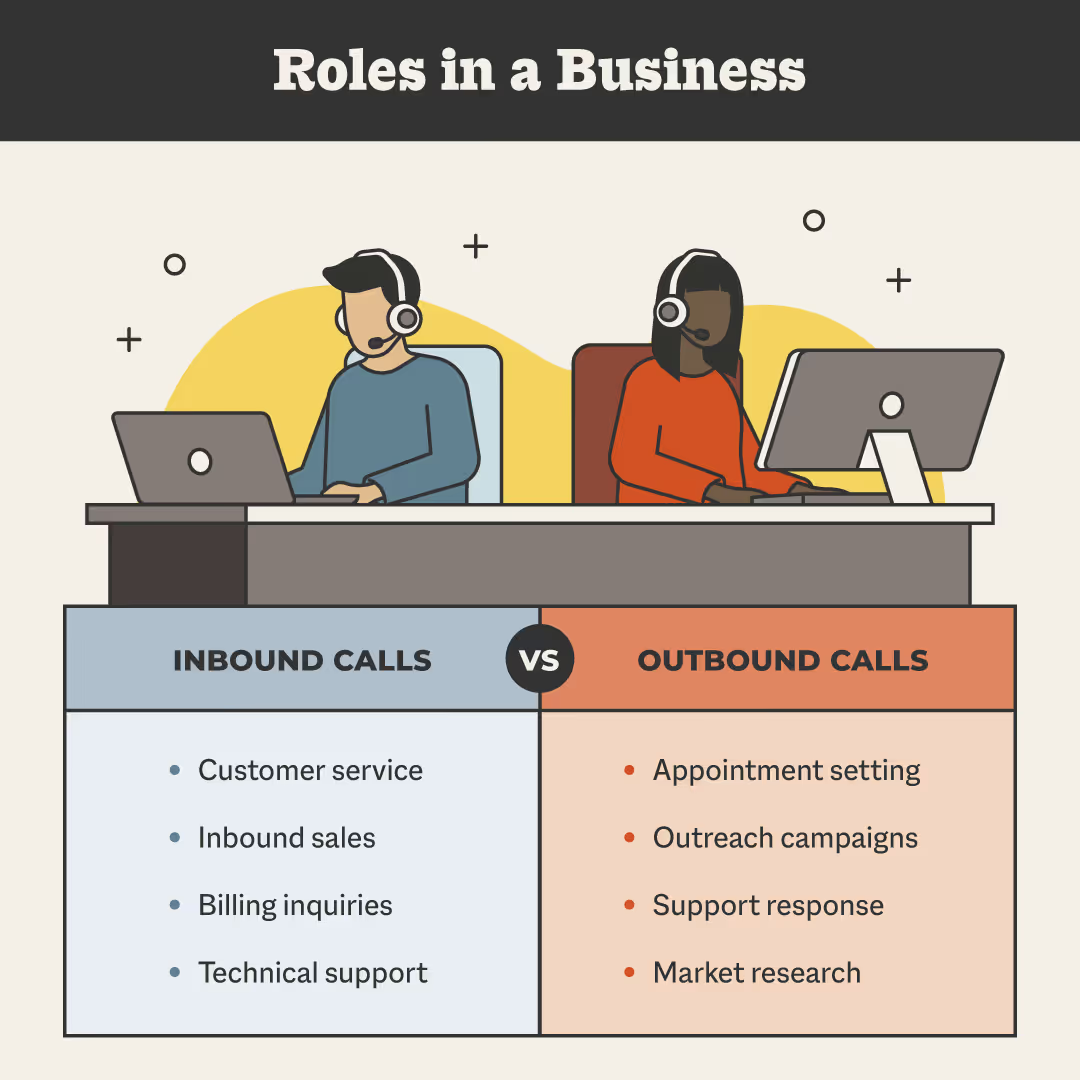Inbound vs. Outbound Calls: Which Is Right For Your Business?
Inbound vs. Outbound Calls: Which Is Right For Your Business?

In this day and age of social media, email, and live chat you might guess that people rarely call businesses anymore. The opposite is true, however, as just over 41% of salespeople say that phone calls are the most useful tool they have for dealing with client inquiries.
Both inbound and outbound calls play a major role in many aspects of a business, including customer service, appointment setting, product and service inquiries, and lead generation.
Understanding the distinctions between inbound vs. outbound calls will assist you in deciding which strategy is ideal for your business. But wait — what is the difference between inbound and outbound calls?
In this post, we’ll cover both inbound and outbound calls and their key differences so you can find which call strategy is right for your business.
What are inbound calls?
As the name suggests, inbound calls are calls that are initiated by a prospect or customer. These calls are typically handled by a call center or help desk, though this isn't always the case in smaller organizations, where one or two people may be responsible for all calls.
Inbound calls are used for a variety of things, including customer service, tech support, product or service inquiries, inbound sales, and more. With 56% of calls coming to your business being viable leads, inbound calls play an important role in your business.

What are outbound calls?
Outbound calls are calls that you initiate to a client or prospect, such as a cold call, response to a support request, to inform a customer about a new service, or to collect survey data.
One of the most prevalent uses of outbound calling are for cold calls, in which salespeople contact leads who could potentially be interested in a product or service. Although cold calling may appear contentious, a Crunchbase study found that organizations that don’t cold call experienced 42% less growth than those who do.
Another example of outbound calling is when a company offers a “callback” feature. Rather than forcing consumers to wait and listen to unbearable elevator music until a representative can reach them, businesses offer a support response where the representative will call the prospect back when it's their turn. Although the prospect attempted to call first, reaching back out to them in this matter is considered an outbound call.

The difference between inbound vs. outbound calls
Simply put, the primary distinction between inbound and outbound calling is who initiates the call. If it comes from outside of the company, it’s an inbound call, and if it’s from within the company it’s an outbound call.
To have a better understanding, check out some of these key distinctions between inbound and outbound calls.
Main goals and objectives
The purpose of inbound and outbound calls are to make and receive calls to generate and nurture leads. Both calls, however, use different approaches and methods to achieve their goal.
Inbound calls:
The main objective for inbound calls is to address customer and client concerns in an attempt to build loyalty and increase retention. Agents deal with consumers in a variety of moods and with a variety of demands, so building personal connections and proactively solving problems for each person is crucial to nurturing new and current leads as well as boosting the customer experience.
Outbound calls:
The main goal for outbound calls is to build interest among potential buyers in order to generate sales leads. This requires outbound agents to be more sales-oriented and have a strong desire to keep a customer engaged.
Roles in a business
Since each call has their own objectives, both inbound and outbound calls take on different roles within a company.
Inbound calls may be used for:
- Customer service: These inbound calls help existing customers with their questions or concerns such as returns, over-the-phone payments, policies, etc.
- Inbound sales: These calls happen when prospective buyers call to gain more information about a business's offerings.
- Billing inquiries: Customers can use these calls to help customers them with their payment methods, renewals, and upgrades in their plan.
- Technical support: When something goes wrong on the customer's end, such as a break or bug in a system, these calls are used to solve the issue.
Outbound calls may cover:
- Appointment setting: These calls are used to arrange meetings or appointments between the lead and the salesperson to discuss offerings further.
- Outreach campaigns: Warm and cold calls are used by outbound agents to generate leads, and they recognize potential to pique an individual's interest in the company's products.
- Support response: Rather than making prospects stay on hold for too long, support response is where a representative will call the prospect back when it's their turn.
- Market research: These calls are used to gain insight into the target market by asking questions and gathering data that will be used to modify offerings or adjust marketing strategies.

Which call strategy is right for your business?
If you're having trouble keeping up with the volume of customer service and technical support calls, investing in your inbound call strategy could help. If your team is having trouble finding or following up on a large number of leads, investing in your outbound call strategy may be the ideal option for you.
In either case, if your company is expanding and your workforce is overburdened, your business would likely benefit from phone answering services.
Check out the differences between call answering services so you know which service best fits your business needs.

Try Smith.ai virtual receptionists
As a business owner, you should never overlook the value of both inbound and outbound calls. Even if your inbound call strategy contains excellent customer service, your business won’t grow if you don’t have the right outbound strategy bringing in leads.
Meanwhile, if you're bringing in a lot of leads but don't have enough personnel to answer the phone in a timely manner to assist them, your business could suffer.
If you're having trouble keeping track of your calls, Smith.ai is known for providing top-notch virtual receptionist service, with a variety of options to help you with all of your call demands.
Sign up for a free consultation with our team to see how our professional, 24/7 staff can help your business.
Sources: Sales Insights Lab | Call Source | Crunchbase
Take the faster path to growth. Get Smith.ai today.
Key Areas to Explore
Technical Implementation Terms
Voice user interface (VUl) design
Speech recognition integration
Text-to-speech optimization
API connectivity and webhooks
Real-time data synchronization

Your submission has been received!














.svg)



